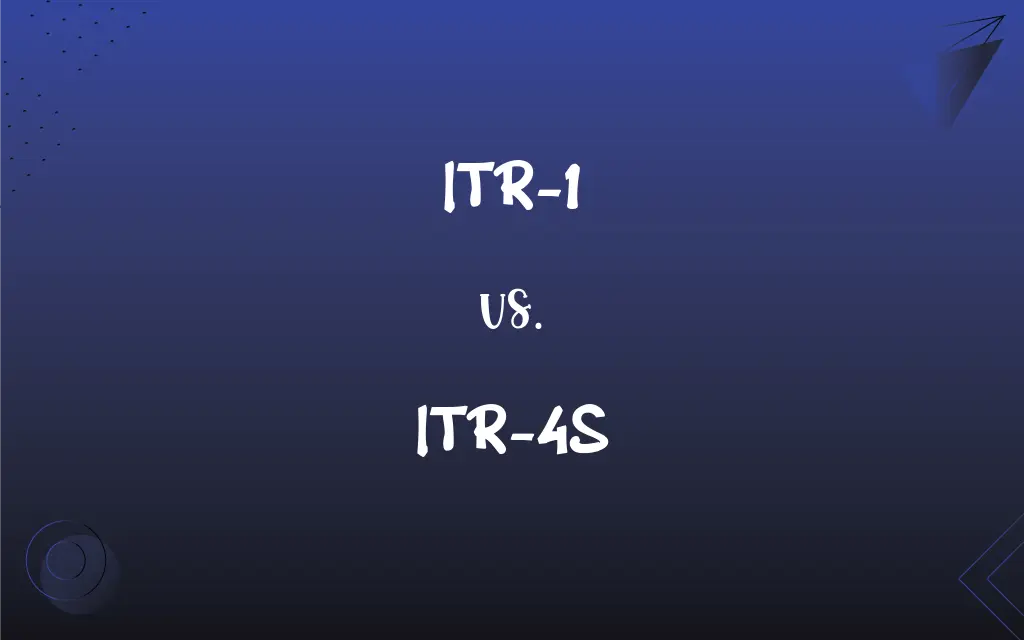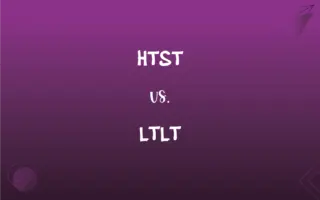ITR-1 vs. ITR-4S: What's the Difference?
Edited by Aimie Carlson || By Janet White || Published on February 21, 2024
ITR-1 is for salaried individuals with income up to ₹50 lakhs, while ITR-4S (Sugam) is for small businesses and professionals under presumptive income scheme.

Key Differences
ITR-1, or 'Sahaj', is designed for salaried individuals earning income from salary, one house property, and other sources like interest, with total income up to ₹50 lakhs. ITR-4S, also known as 'Sugam', caters to small business owners and professionals opting for the presumptive income scheme under sections 44AD, 44ADA, and 44AE of the Income Tax Act.
The ITR-1 form is straightforward, intended for those with simpler financial transactions, without income from capital gains or business/profession. In contrast, ITR-4S is tailored for individuals and HUFs with income from a business or profession calculated on a presumptive basis, simplifying tax calculations by avoiding detailed accounting.
ITR-1 cannot be used by individuals who are either Directors in a company or have invested in unlisted equity shares. ITR-4S, however, is available to small business owners and professionals, including those with income from freelancing, who opt for a simplified taxation scheme.
For ITR-1 filers, disclosing detailed income from various sources like salary and property is mandatory. ITR-4S users, however, are not required to maintain detailed books of accounts and can declare income at a fixed rate on the gross receipts or turnover.
ITR-1 form does not accommodate individuals with income from speculative business, like intraday stock trading, whereas ITR-4S is more accommodating for small business owners with varied types of income under the presumptive scheme.
ADVERTISEMENT
Comparison Chart
Eligible Taxpayers
Salaried individuals, one house property owners
Small business owners, professionals
Income Criteria
Up to ₹50 lakhs from salary, property, interest
Business income on presumptive basis
Exclusions
Cannot be used by company directors or those with unlisted equity investments
Not for regular businesses with detailed accounts
Accounting Requirements
Detailed income disclosure required
No detailed bookkeeping, fixed-rate income
Applicability
Simpler financial situations
Small businesses, freelancers under presumptive scheme
ADVERTISEMENT
ITR-1 and ITR-4S Definitions
ITR-1
ITR-1 is designed for those with income excluding winnings from lottery or racehorses.
As her income sources were salary and rent, she filed her taxes using ITR-1.
ITR-4S
ITR-4S is not for individuals with regular business income requiring detailed accounts.
As a small trader, ITR-4S was ideal for his business, freeing him from detailed accounting.
ITR-1
ITR-1 cannot be used by company directors or individuals with unlisted equity shares.
Being a director in a company, he couldn't use the ITR-1 form for his tax return.
ITR-4S
ITR-4S is for those with income from business and profession calculated on a presumptive basis.
His income from freelancing was declared using ITR-4S, simplifying his tax filing.
ITR-1
ITR-1 is for individuals with income from salary, one house property, and other sources.
He filed an ITR-1 as his income included salary and interest from savings.
ITR-4S
ITR-4S is for small business owners and professionals under the presumptive income scheme.
As a small shop owner, he filed his taxes using ITR-4S under the presumptive scheme.
ITR-1
ITR-1 is suitable for taxpayers with a total income of up to ₹50 lakhs.
His total income was below ₹50 lakhs, making him eligible for ITR-1 filing.
ITR-4S
ITR-4S is suitable for individuals opting for a simplified tax calculation method.
She chose ITR-4S to avoid detailed bookkeeping for her freelance income.
ITR-1
ITR-1 is used by salaried individuals not having capital gains or business income.
Since she had no business income, she opted for the simpler ITR-1 form.
ITR-4S
ITR-4S allows for a fixed rate of income declaration on gross receipts or turnover.
He used ITR-4S to declare his business income at a fixed rate based on turnover.
FAQs
What is the income limit for filing ITR-1?
The income limit for ITR-1 is up to ₹50 lakhs.
Can I file ITR-1 if I have rental income?
Yes, if you have income from one house property, you can file ITR-1.
Is ITR-4S applicable for regular business income?
No, ITR-4S is for businesses opting for the presumptive income scheme, not for regular business income.
Who should use ITR-4S?
ITR-4S is for small business owners and professionals under the presumptive income scheme.
Is ITR-1 suitable for individuals with capital gains?
No, ITR-1 cannot be used if you have capital gains income.
Can company directors file ITR-1?
No, company directors cannot file ITR-1.
Are there any restrictions on turnover for ITR-4S filers?
Yes, there are turnover limits under the presumptive income scheme for ITR-4S.
Can ITR-4S be filed by salaried individuals?
ITR-4S is generally not for salaried individuals unless they have presumptive business income.
What if my income exceeds ₹50 lakhs? Can I still file ITR-1?
No, if your income exceeds ₹50 lakhs, you cannot file ITR-1.
Is detailed accounting required for ITR-1?
ITR-1 requires detailed disclosure of income from various sources like salary and property.
What is ITR-1 used for?
ITR-1 is for salaried individuals with income from salary, one house property, and other sources like interest.
What are the major benefits of filing ITR-4S?
ITR-4S simplifies tax filing for small businesses with presumptive income, without detailed bookkeeping.
Can pensioners file ITR-1?
Yes, pensioners can file ITR-1 if their income falls under the specified categories.
Is ITR-4S suitable for large businesses?
No, ITR-4S is designed for small businesses and professionals under the presumptive scheme.
Can a freelancer use ITR-4S?
Yes, freelancers can use ITR-4S if they opt for the presumptive taxation scheme.
Are interest incomes covered under ITR-1?
Yes, interest incomes like savings account interest are covered under ITR-1.
Can I file ITR-4S if I have multiple businesses?
Yes, but the total income should be within the limits of the presumptive scheme.
What type of house property income is allowed in ITR-1?
Income from one house property, excluding cases where the property is carried forward or loss under the head ‘Income from house property’.
Does ITR-4S require details of all business expenses?
No, ITR-4S allows for income declaration at a fixed rate, reducing the need for detailed expense tracking.
Does ITR-4S cover professional incomes like doctors and lawyers?
Yes, professionals like doctors and lawyers can use ITR-4S if they opt for the presumptive income scheme.
About Author
Written by
Janet WhiteJanet White has been an esteemed writer and blogger for Difference Wiki. Holding a Master's degree in Science and Medical Journalism from the prestigious Boston University, she has consistently demonstrated her expertise and passion for her field. When she's not immersed in her work, Janet relishes her time exercising, delving into a good book, and cherishing moments with friends and family.
Edited by
Aimie CarlsonAimie Carlson, holding a master's degree in English literature, is a fervent English language enthusiast. She lends her writing talents to Difference Wiki, a prominent website that specializes in comparisons, offering readers insightful analyses that both captivate and inform.
































































